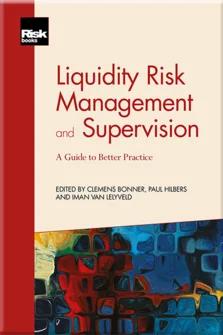Bank-Level Liquidity Stress-Testing
Clemens Bonner, Iman van Lelyveld and Andreas Katteneder
Introduction to ‘Liquidity Risk Management and Supervision’
Liquidity Regulation, the 2007-9 Crisis and the Regulatory Response
Sources of Liquidity Risk: Theory and Empirical Evidence
The Process of Liquidity Supervision
How to Implement ILAAP: Lessons Learned at Rabobank
Liquidity Risk Management Strategy and Tolerance
Liquidity Buffer Management and Banks’ Counterbalancing Capacity
Bank-Level Liquidity Stress-Testing
Contingency Funding Plans
Liquidity Transfer Pricing
Intraday Liquidity Risk Management
Putting Liquidity Risk Management into a Wider Context
Macroprudential Liquidity Stress Tests
A Simple Macroprudential Liquidity Buffer
Liquidity stress-testing can be seen as a thorough analysis of an institution’s ability to cover net cash outflows. It complements Pillar 1 standards, such as the liquidity coverage ratio (LCR) or net stable funding ratio (NSFR), as it can take into account different time horizons, different stress scenarios and additionally account for institution-specific and country-specific factors.
Stress-testing is an important tool for banks as part of their internal risk management. By providing forward-looking risk assessments, facilitating the development of risk mitigation or contingency plans, the implementation of adequate liquidity-specific stress tests is important for both regulators and banks themselves (Basel Committee on Banking Supervision 2009).
Liquidity is typically managed assuming “business as usual”. However, since liquidity crises tend to occur suddenly, a bank is expected to manage liquidity under stressed conditions in order to identify and quantify its exposures, analysing possible impacts on the bank’s cashflow profile, liquidity position, profitability and solvency. Liquidity stress tests measure a bank’s ability to meet its payment obligations on time at
Copyright Infopro Digital Limited. All rights reserved.
As outlined in our terms and conditions, https://www.infopro-digital.com/terms-and-conditions/subscriptions/ (point 2.4), printing is limited to a single copy.
If you would like to purchase additional rights please email info@risk.net
Copyright Infopro Digital Limited. All rights reserved.
You may share this content using our article tools. As outlined in our terms and conditions, https://www.infopro-digital.com/terms-and-conditions/subscriptions/ (clause 2.4), an Authorised User may only make one copy of the materials for their own personal use. You must also comply with the restrictions in clause 2.5.
If you would like to purchase additional rights please email info@risk.net











